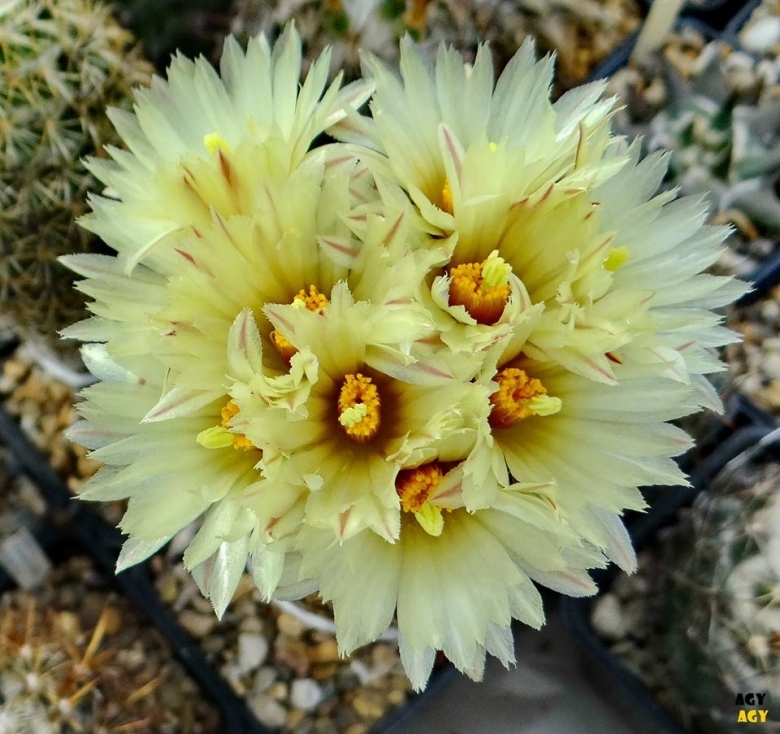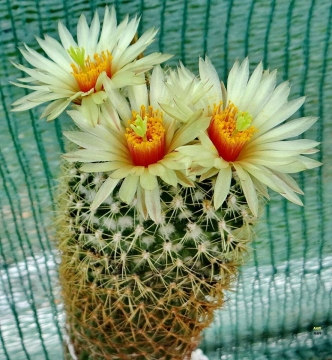Accepted Scientific Name: Coryphantha erecta Lem.
Cact. 34.

Mammillaria elongata var. erecta (Coryphantha erecta) Photo by: Agócs György
Origin and Habitat: Coryphantha erectaSN|3941]]SN|3941]] is endemic to Mexico, where it occurs in the states of Guanajuato, Hidalgo, Querétaro and San Luis Potosí. It is extremely widely distributed and abundant.
Altitude range: 1200-2300 metres above sea level.
Habitat and Ecology: Southern Chihuahuan Desert Region. This cactus grows in dry shrubland mostly on the rocky slopes of high mountains on calcareous gravels and on igneous rock substrate. Accompanying species can be Echinocactus horizonthaloniusSN|1711]]SN|1711]], Ancistrocactus crassihamatusSN|3434]]SN|3434]], Mammillaria zephyranthoidesSN|5468]]SN|5468]], Echinocereus cinerascensSN|7775]]SN|7775]], Echinofossulocactus dichroacanthusSN|6255]]SN|6255]], Opuntia streptacantha, Myrtillocactus geometrizansSN|8050]]SN|8050]], Jatropha spathulata, Neolloydia conoideaSN|10089]]SN|10089]], Dodonaea viscosa, Ferocactus histrixSN|4300]]SN|4300]], Stenocereus dumortieriSN|7942]]SN|7942]], Agave feroxSN|27883]]SN|27903]], Agave strictaSN|568]]SN|568]] and Agave salmianaSN|27903]]SN|27883]]. There are no major threats. Some subpopulation are declining due to conversion of habitat to farmland, roads (paving) as well as mining activities.
Synonyms:
Common Names include:
ENGLISH: Pincushion cactus, Hedgehog cactus
Description: Coryphantha erectaSN|3941]]SN|3941]], as the name implies, is a large, columnar species, simple at first, eventually clustering from the base and does not have stolons or taproots. Although this species may be grown in specialist collections it is not widely sought after as an ornamental.
Stem: Cylindrical, yellowish green to vivid green, 30 (rarely to 50) tall, 5-8 cm in diameter.
Tubercles: Loosely arranged, obliquely conic, c. 8 mm tall, somewhat rhombiform at base; axils of young tubercles white-woolly and small yellow glands. A groove on the top of the tubercule, connecting the growing points, is characteristic of the genus Coryphantha and distinguishes it from Mammillaria, however {Coryphantha erectaSN|3941]]SN|3941]]} may have grooved and grooveless tubercles on the same mature heads at the same time, or may change the form of its growth back and forth from the one to the other.
Radial spines: 8 to 14 (rarely to 18), yellowish, amber-yellow or golden brown, spreading, straight, subulate to awl shaped, ascending, to 1.2 cm long.
Central spines: 2 (rarely to 4), yellowish brown, downward pointing, upper one short, lower one curved up to 2 cm long.
Flowers: Flowers short funnelform, nearly rotate, variable in size usually large, 5-6 cm long, 5-7 cm Ø, yellow; perianth-segments very narrow.
Fruit: Cylindrical, 1.5-2 cm long, to 1 cm in diameter, green.
Bibliography: Major references and further lectures
1) Edward Anderson “The Cactus family” Timber Press, Incorporated, 2001
2) James Cullen, Sabina G. Knees, H. Suzanne Cubey "The European Garden Flora Flowering Plants: A Manual for the Identification of Plants Cultivated in Europe, Both Out-of-Doors and Under Glass" Cambridge University Press, 11/Aug/2011
3) David R Hunt; Nigel P Taylor; Graham Charles; International Cactaceae Systematics Group. "The New Cactus Lexicon" dh books, 2006
4) N. L. Britton, J. N. Rose “The Cactaceae. Descriptions and Illustrations of Plants of the Cactus Family.” Volume 4, The Carnegie Institution of Washington, Washington 1923
5) Curt Backeberg “Die Cactaceae: Handbuch der Kakteenkunde” Gustav Fischer Verlag, Stuttgart New York 1982–1985
6) Reto Dicht, Adrian Lüthy “Coryphantha: Cacti of Mexico and Southern USA” Springer Science & Business Media, 14 March 2006
7) Sánchez , E., Guadalupe Martínez, J., Bárcenas Luna, R., Dicht, R.F. & Lüthy, A.D. 2013. Coryphantha erecta. The IUCN Red List of Threatened Species. Version 2015.1. <www.iucnredlist.org>. Downloaded on 08 June 2015.
8) Del Weniger “Cacti of the Southwest: Texas, New Mexico, Oklahoma, Arkansas, and Louisiana” University of Texas Press, 1969
9) E Haustein “Der Kosmos Kakteenfuehrer (the Kosmos Cactus Guide)” Balogh Scientific Books, United States, 01/Dec/1998
10) Clive Innes, Charles Glass “Cacti” Portland House, 1991
 Mammillaria elongata var. erecta (Coryphantha erecta) Photo by: Agócs György
Mammillaria elongata var. erecta (Coryphantha erecta) Photo by: Agócs GyörgySend a photo of this plant.The gallery now contains thousands of pictures, however it is possible to do even more. We are, of course, seeking photos of species not yet shown in the gallery but not only that, we are also looking for better pictures than those already present.
Read More... Cultivation and Propagation: Coryphantha erectaSN|3941]]SN|3941]] is easy to grow. It comes from an area of summer rainfall. Keep drier in winter (but for outdoor cultivation it is quite resistant to wet conditions, too). Very cold resistant, hardy about to about -5 to -10° C, but the frost resistance varies a lot from clone to clone. Needs good drainage. Keep drier in winter, Full sun to partial shade.
Propagation: Seeds (no dormancy requirement, they germinate best at 25°C) or by offsets (if available), or occasionally grafted.











